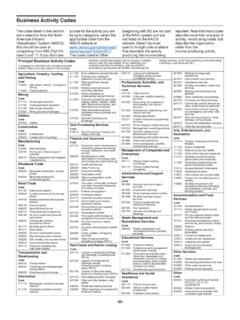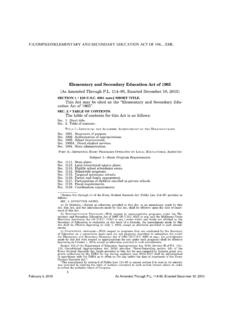Transcription of 2. THE ECONOMIC BENEFITS OF EDUCATION - OECD
1 392. THE ECONOMIC BENEFITSOF EDUCATIONHow much more do tertiary graduates earn?How does EDUCATION affect employment rates?What are the incentives for people to invest in EDUCATION ?What are the incentives for societies to invest in EDUCATION ?HIGHLIGHTS FROM EDUCATION AT A GLANCE 2008 ISBN 978-92-64-04061-8 OECD 2009402. THE ECONOMIC BENEFITS OF EDUCATIONHow much more do tertiary graduates earn? Earnings increase with each level of EDUCATION . Graduates of tertiary EDUCATION earn more than peoplewho completed only upper secondary EDUCATION , with thegap ranging from 15% in New Zealand to 119% inHungary. Older adults (55-64 year-olds) with tertiary educationtypically enjoy an even larger earnings premium than thegeneral working-age indicator examines the relative earnings ofworkers with different levels of EDUCATION .
2 Althoughhigher levels of EDUCATION are strongly linked to raisedincomes, evidence suggests that some individualsmight be receiving relatively low returns on theirinvestment in EDUCATION that is, they earn relativelylow wages even though they have relatively highlevels of difference in earnings between tertiary graduatesand people who have completed only upper secondaryeducation is generally greater that between peoplewho have completed upper secondary and peoplewho have only completed lower secondary earnings premium for adults (25-64 year-olds)with tertiary EDUCATION , compared with upper-s e c ondary EDUCATION , ranges from 15% in NewZealand to 119% in EDUCATION boosts women s earnings morethan men s in 10 of the 25 OECD countries examinedin this indicator (Australia, Austria, Canada, Korea,the Netherlands, New Zealand, Norway, Spain,Switzerland and the United Kingdom).
3 The reverse istrue for the remaining countries, except for Turkey,where the BENEFITS are about the same. However, in allcountries, and at all levels of educational attainment,women generally earn less than their male people (55-64 year-olds) with tertiary educationenjoy an even larger earnings premium than thegeneral population as well as improved employmentprospects. By contrast, older people with only lowersecondary EDUCATION see a widening in the earningsgap in every country bar Finland, Germany andNew Zealand. In most countries, tertiary educationincreases the prospect of being employed at an olderage and keeps improving earnings and productivitydifferentials through to the end of working life(see Charts and in EDUCATION at a Glance 2008).Although the better educated usually earn more, thisis not always the case.
4 In some countries, factors suchas national wage agreements tie many workers tosimilar salaries regardless of EDUCATION levels. At theindividual level, educational attainment is only onefactor in determining an individual s income experi-ence and personal characteristics also play a , research from the United States suggests thatfor women and ethnic minorities, more than halfof the variance in earnings cannot be explained byquantifiable factors, such as length of time in educa-tion or the on earnings are before income tax, except forBelgium, Korea and Turkey. Data on earnings for indi-viduals in part-time work are excluded for the CzechRepublic, Hungary, Luxembourg and Poland, whiledata on part-year earnings are excluded for Hungary,Luxembourg and reading from OECDU nderstanding the Social Outcomes of Learning (2007).
5 Going furtherFor additional material, notes and a full explana-tion of sourcing and methodologies, see Educationat a Glance 2008 (Indicator A9).Areas covered include: Trends in relative earnings of the population. Differences in earnings by gender and by THE ECONOMIC BENEFITS OF EDUCATIONHIGHLIGHTS FROM EDUCATION AT A GLANCE 2008 ISBN 978-92-64-04061-8 OECD 200941 How much more do tertiary graduates earn?Figure earnings from employment, 2006 These figures show the earnings of adult men and women (25-64 year-olds) by their level of educational attainment (relativeto the earnings of graduates of upper secondary and post- secondary non-tertiary EDUCATION ).Source:OECD (2008), EDUCATION at a Glance 2008, Table , available at secondary and post- secondary non-tertiary EDUCATION = above this line indicate that men in the specified category earn more than men with only upper secondary EDUCATION .
6 Bars below indicate they earn secondary and post- secondary non-tertiary EDUCATION = above this line indicate that women in the specified category earn more than women with only upper secondary EDUCATION . Bars below indicate they earn upper secondary educationVocationally-oriented tertiary EDUCATION University-level and advanced research programmesMenHungaryPolandCzech RepublicUnited StatesIrelandItalyPortugalAustriaFinland FranceGermanyLuxembourgCanadaTurkeyUnite d KingdomBelgiumSwitzerlandSwedenSpainAust raliaDenmarkKoreaNorwayNew ZealandWomenKoreaUnited KingdomHungaryIrelandUnited StatesCanadaPortugalPolandGermanyCzech RepublicSwitzerlandAustriaFinlandTurkeyF ranceAustraliaSpainBelgiumLuxembourgNew ZealandItalyNorwaySwedenDenmarkHIGHLIGHT S FROM EDUCATION AT A GLANCE 2008 ISBN 978-92-64-04061-8 OECD 2009422. THE ECONOMIC BENEFITS OF EDUCATIONHow does EDUCATION affect employment rates?
7 In most countries, employment rates increase as people slevels of EDUCATION rise tertiary graduates are morelikely to be employed than upper secondary graduates. Differences in employment rates between men andwomen are widest among low educated groups. Increasingly, people with upper secondary EDUCATION andabove are less likely to be unemployed than those withlower levels of indicator examines the relationship betweeneducation and employment. The better educated indi-viduals are, the more likely they are to be populations in OECD countries age, higher levels ofeducation and longer participation in employmentcan help to ensure more people are economicallyactive and help to alleviate the burden of financingpublic pension rates for graduates of tertiary educationare around 9% higher, on average, than for graduates ofupper secondary EDUCATION .
8 In Greece, Poland, the Slo-vak Republic and Turkey, that difference is 12% or h e g a p i n e m p l o y m e n t r a t e s a m o n g m e naged 25 to 64 is particularly wide between those whohave completed upper secondary school and thosewho have not. In the Czech Republic, Hungary and theSlovak Republic, the difference is extreme, with ratesof employment among men with a higher level ofeducation at least 30% higher than those with a lowerlevel of employment rates differ among OECD coun-tries, it is largely the result of variations in the level ofwomen s participation in the workforce in individualcountries. That said, employment rates for women aregenerally lower than those for men. For those withvery low levels of EDUCATION , the gap is particularlywide. The gap between men and women s employ-ment rates is 10 percentage points at tertiary level,widening to 23 percentage points at below upper- secondary employment rates for 55-64 year-olds aregenerally lower than those of the working-age popula-tion as a whole (by about 20 percentage points), theyhave been increasing in recent years, particularlyamong the more educated.
9 In this age group, theaverage employment rate stands at for thosewith below upper secondary EDUCATION , forthose with upper secondary and post- secondary non-tertiary EDUCATION , and for those with 1997 and 2006, the difference in unemploy-ment rates between people with tertiary educationand those with upper secondary and post-secondarynon-tertiary educ ation decreased; but the gapbetween people in this latter group and those withless than upper secondary EDUCATION increased from to (see Table in EDUCATION at aGlance 2008). For those with only lower secondary edu-cation, it is becoming more difficult to find employ-ment, which suggests that in most OECD countries,this skill level is not sufficient to obtain a suitable persons are defined as those who, duringthe survey reference week, work for pay or profit for atleast one hour, or have a job, but are temporarily notat work because of injury, illness, holiday, strike, edu-cation leave, maternity or paternity leave, etc.
10 Unem-ployed persons are defined as those who are, duringthe survey reference week, without work, activelyseeking employment and available to start furtherFor additional material, notes and a full explana-tion of sourcing and methodologies, see Educationat a Glance 2008 (Indicator A8).Areas covered include: Employment rates and educational attain-ment, by gender. Unemployment rates and educational attain-ment, by gender. Trends in employment and unemploymentrates, by educational THE ECONOMIC BENEFITS OF EDUCATIONHIGHLIGHTS FROM EDUCATION AT A GLANCE 2008 ISBN 978-92-64-04061-8 OECD 200943 How does EDUCATION affect employment rates?Figure rates by level of educational attainment, 2006 These figures show the employment rates for men and women depending on their levels of EDUCATION . Graduates of tertiaryeducation are more likely to have a job than people whose EDUCATION ended before upper secondary .














